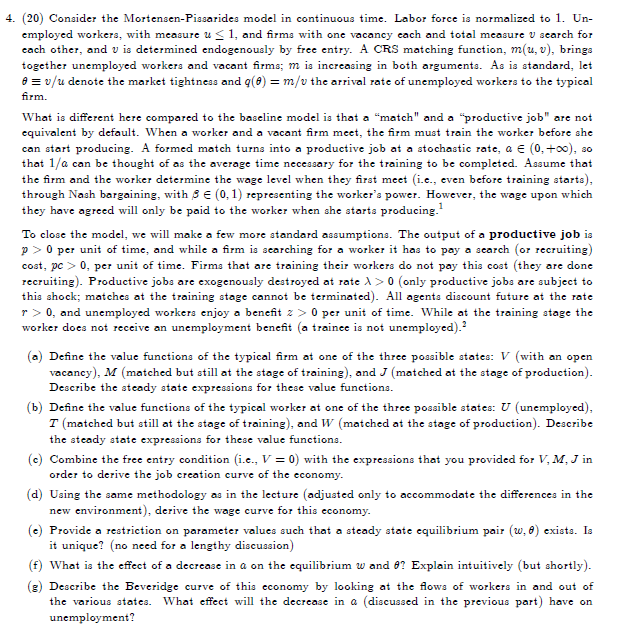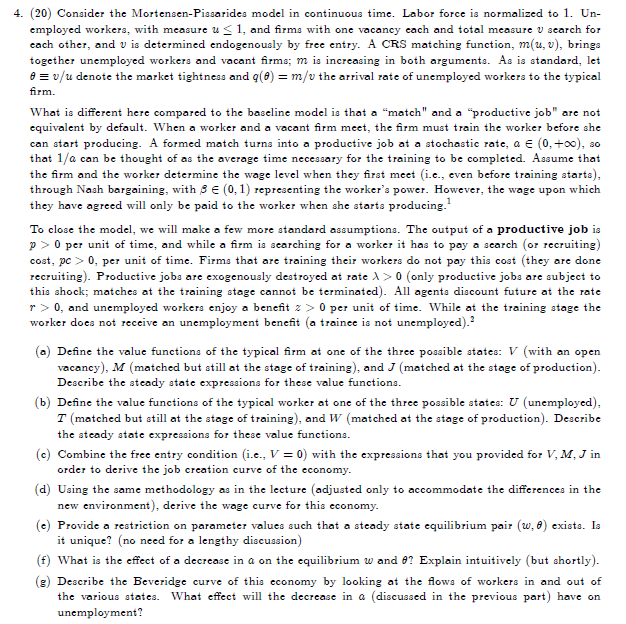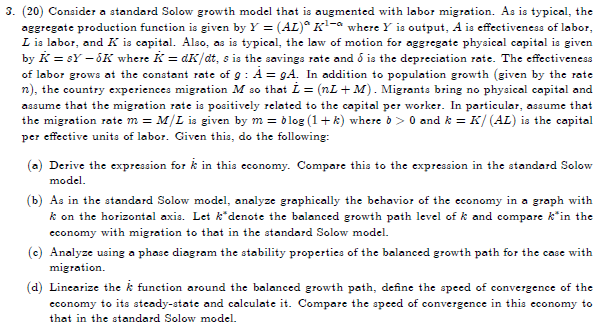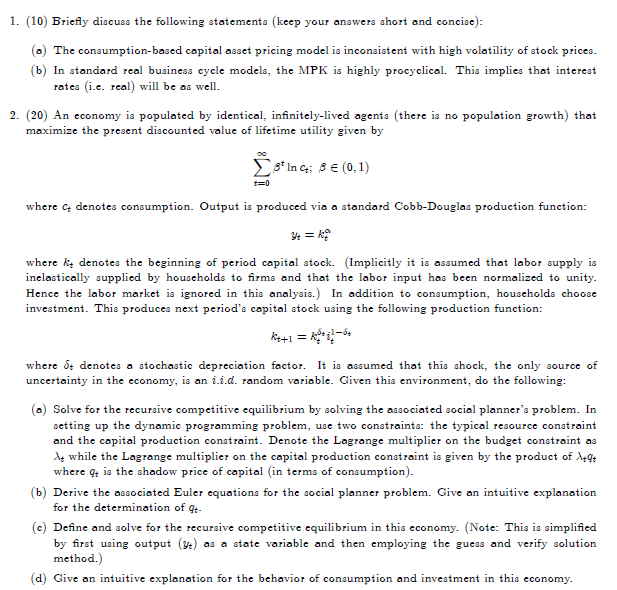



Provide references.
4. [2'0] Consider the lvlortensenPissarides model in continuous time. Labor force is normalized to 1. Un employed workers, with measure ti. E l., and rms with one vacancy each and total measure 13 search for each other, and 13 is determined endogenously by free entry. 3'. CR3 matching function, m|[u, 1:], brings together unemployed workers and vacant rms; or. is increasing in both argLLments. As is standard, let 3 E 13ft; denote the market tightness and q[] = mfv the arrival rate of unemployed workers to the typical rm. 1|What is dierent here compared to the baseline model is that a "match" and a \"productive jolin"I are not equivalent by default. 'When a worker and a vacant rm meet, the rm must train the worker before she can start producing. .F'L formed match turns into a productive job at a stochastic rate, a. E {ll._+ooj, so that 1ft: can be thought of as the average time necessary for the training to be completed. Assume that the rm and the worker determine the wage level when they rst meet [i.e., even before training starts], through Nash bargaining, with ,3 E [0, 1] representing the worker's power. However, the wage upon which they have agreed will only he paid to the worker when she starts producing} 'Ib close the model, we will make a few more standard assumptions. The output of a product it\"! job is p 1':- Il per unit of time, and while a rm is searching for a worker it has to pay a search [or recruiting] cost, pt: 2:- tl, per unit of time. Firms that are training their workers do not pay this cost [they are done recruiting}. Productive jobs are eocogenously destroyed at rate 3|. :5- Il' [only productive jobs are subject to this shock; matches at the training stage cannot he terminated]. All agents discount future at the rate El" 33: (l, and Imemployed workers enjoy a benet 2' 3:- Il per unit of time. 1|mic-"bile at the training stage the worker does not receive an unemployment benet [a trainee is not unemployed}; [a] Dene the value functions of the typical rm at one of the three possible states: 1,.- [with an open vacancy], M [matched but still at the stage of training], and J [matched at the stage ofproduction]. Describe the steady state expressions for these value functions. [b] Dene the value functions of the typical worker at one of the three possible states: U [unemployed], T [matched but still at the stage of training}, and T-V [matched at the stage of production]. Describe the steady state expressions for these value functions. [c] Combine the free entry condition [i.e., V = ll} with the expressions that you provided for V, M, J in order to derive the job creation curve of the economy. [d] Using the same methodology as in the lecture [adjusted only to accommodate the dierences in the new environment}, derive the wage curve for this economy. e row a restriction on rameter va ues su t t a ste y state r1um r w, crusts. P 'de ' ' pa 1 ch ha ad equilib ' pai a ' Is it unique? [no need for a lengthy discussion] [f] \"Flint is the eCEect of a decrease in e on the equilibrium in and ti\"! Explain intuitively {but shortly]. [g] Describe the Beveridge curve of this economy by looking at the ows of workers in and out of the various states. 1|nn'l-rhat elfect will the decrease in o [discussed in the previous part] have on unemployment? 4. [2'0] Consider the MortensenPissarides model in continuous tin:Le. Labor force is normalized to 1. Un employed workers. with measure 11. E 11 and rms with one vacancy each and total measure 1] search for each other, and 13 is determined endogenously by free entry. 1". CR5 matching function, mum], brings together unemployed workers and vacant rnls; m is increasing in both arguments. As is standard1 let ti E lift; denote the market tightness and El\" 2 mf' the arrival rate of unemployed workers to the typical rm. 1|n'Ia-rhat is diEerent here compared to the baseline model is that a umatchll and a Lproductive job"I are not equivalent by default. 1W'hen a worker and a vacant rm meet, the rm must train the worker before she can start producing. 45L formed match turns into a productive job at a stochastic rate1 a E [I:I._+:b<:l so that lf can be thought ofas the average time necessary for training to completed. assume rm and worker determine wage level when they rst meet even before starts through nash bargaining with e representing power. however1 upon which have agreed will only paid she producing.1 close model1 we make a few more standard assumptions. output of productive job is p per unit time._ while searching it has pay search recruiting cost1 pt: :5- time. firms are their workers do not this cost done jobs exogenously destroyed at rate .3: d subject shock matches stage cannot terminated all agents discount future :i :3 unemployed enjoy benet i does receive an unemployment trainee dene value functions typical one three possible states: v open vacancy m but still j ofproduction describe steady state expressions these functions. if t r production combine free entry condition ll you provided m: in order derive creation curve economy. using same methodology as lecture accommodate diermces new environment provide restriction on parameter values such equilibrium pair exists. unique need lengthy discussion i-vhat ecect decrease c ii explain intuitively shortly beveridge economy by looking ows out various states. s previous part consider solow growth model augmented labor migration. aggregate function given y='(11.5)\"' k1_ where output1 eectiveness labor1 l k capital. also typical1 law motion physical capital h="SY" ek savings :5 depreciation rate. cceectiveness grows constant : addition population country experiences migration . migrants bring no positively related worker. particular1 mil il eeective units labor. lgiven following: expression p: compare model. lls analyze graphically behavior graph horizontal axis. let balanced path rain phase diagram stability properties case linearize around decline speed convergence its steadystate calculate it. l. briey discuss following statements your answers short concise consumptionbased asset pricing inconsistent high volatility st ocl-c prices. real business cycle models1 mph highly procyelical implies interest rates well. .f economj.r populated identical innitely-lived maximize present discounted lifetime utility did esme .5 denotes consumption. produced via cobbdouglas function: kg beginning period stock. assumed supply inelastically supplied households rms input been normalized unity. hence market ignored analysis. consumption1 choose investment. produces next stock iltowing m1="kir-" g :5: stochastic ctor. source uncertainty economy1 lid. random variable. environment._ solve recursive competitive solving associated social planner problem. setting up dynamic programming problem1 use two constraints: resource constraint constraint. denote lagrange multiplier budget product a443 shadow price terms consumption euler equations give intuitive explanation determination ir. reclusive simplied variable then employing guess verify solution method. ofconsumption investment>














